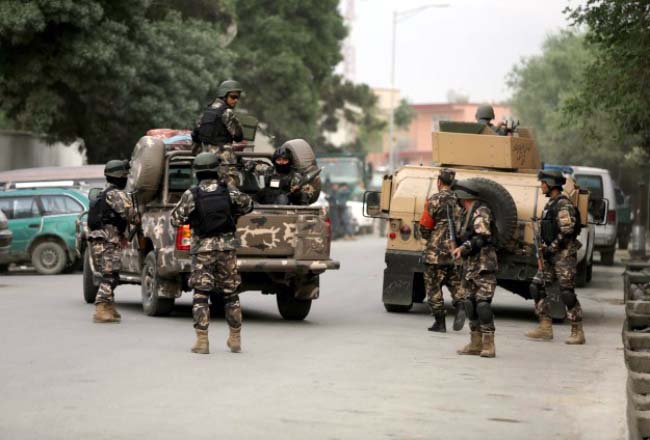With the bitter battle going on between Taliban fighters and government forces in the southern Helmand province, the Resolute Support Mission is sending hundreds of additional American troops to the province to help Afghan forces fighting the Taliban. In recent months, Helmand province witnessed fierce fighting between Afghan government forces and the insurgents trying to capture key districts from the Afghan army. The embattled government forces are reportedly under immense pressures from a rare winter-time heavy Taliban offensive from many fronts in the province. There have been fresh reports in recent weeks of Afghan security forces coming under fresh offensives from the Taliban.
The dispatch of additional US troops to the province is coming at a time when the Taliban are preparing for a heightened military campaign in the province. It is highly likely that the upcoming seasonal fighting in the province would be far bitter as the Taliban are going to focus on making gains on the battlegrounds in the province. The ongoing offensive of the Taliban has been somehow unexpected as usually we were witnessing some lulls in the previous winter seasons across the country. But Taliban’s offensives this winter in Helmand and northern Baghlan provinces are signs that the group is preparing the ground for a more heightened war next spring and summer seasons.
The current contingent of American forces stationed in the province to assist and advise Afghan army and police forces has been under increased pressures due to the increased focus of the Taliban on the southern province. American troops stationed in the province under the Resolute Support Mission play a key role in advising and training Afghan security forces in fighting the Taliban and maintaining security in the volatile provinces. The deployment of the additional American forces will be crucially helpful for the Afghan army and police units fighting the Taliban in the province. The new contingent of American forces can help the Afghan forces engaged in the fighting better plan and prepare for a new and bitter summer fighting in the province.
The Afghan army and police forces in combat still remain reliant to the foreign troops’ assistance in intelligence, coordination, planning, surveillance, logistic and aerial support. Lack of the mentioned key capabilities particularly proper coordination in the Afghan army and police ranks has been the main factor behind the setbacks experienced by Afghan security forces last year. The Afghan security forces’ responses to the immense offensives of the Taliban last year were more reactive and arbitrary rather than through an efficient strategy to counter pop-up offensives of the militants throughout the country. The pattern of the Taliban offensives in the upcoming summer fighting would probably be the same as last year. In 2015, the militants aimed to stretch Afghan forces on many fronts while fighting for specific military gains in few but strategically important areas. The Taliban launched offensives in some southern and eastern provinces, while they massed fighters in the north for taking key areas that could serve as safe havens for the militant groups. On the other hand, the Taliban’s war strategy has significantly changed with the aim to portray a more powerful image for the insurgency. The Taliban now fight more conventional wars and mobilize more fighters to focus on key areas through large-scale offensives rather than low-profile bombings and suicide attacks.
The Afghan security forces need to counter Taliban’s tactics. The next year summer fighting will be a major test for the Afghan security forces for their capabilities to adjust their response to the shifting military approaches of the Taliban. The army and police will need to mount heavier offensives over short periods of time in response to pop-up offensives of the Taliban. Only with quick and more powerful military response to the militants’ offensives, the government forces can then focus on maintaining security for long. The Afghan security forces should not be trapped in the faulty approach of showing momentary but weak response to a Taliban offensive.
The government needs to ensure that there are more than sufficient military preparations for the possible upcoming battle in the Southern key province. The government needs to further boost the Afghan air force to become able to provide aerial support on the battlefields. The national unity government is credited for convincing the international community in particularly the United States and India to provide warplanes for Afghanistan’s fledgling air force. This is expected to make a noticeable difference for government forces. On the other hand, the Afghan government needs to persuade the US for more active military support to the Afghan security forces in the coming years.
The upcoming battle will be key for the government’s efforts to start peace negotiations with the Taliban. The Taliban cannot be persuaded into peace talks without being militarily defeated. The militant groups will only realize their need to come to peace talks when they fail to make gains on the ground. A key objective of the Taliban in the heightened military offensives after conclusion of US combat mission is to make military gains before any sort of peace talks between the militants and the Afghan government starts. If the Taliban manage to make important gains on the ground, it would make it even more difficult for the government of Afghanistan to reach a peace deal that ends the conflict. The increased fighting could also be aimed at disrupting the peace talks as many in the Taliban are opposed to the talks. There is a race against time as another season of war and peace efforts is approaching. The Afghan government has few options, but there are always sufficient opportunities to do its job better.
Home » Opinion » The Battle for Helmand
The Battle for Helmand
| Abdul Ahad Bahrami

